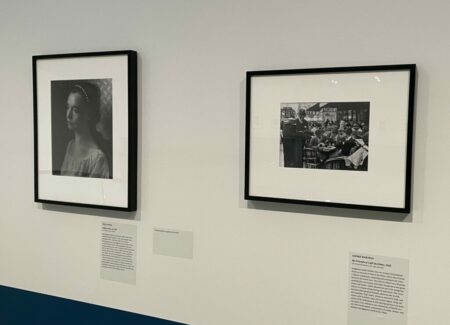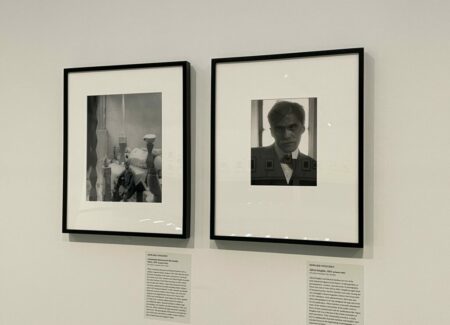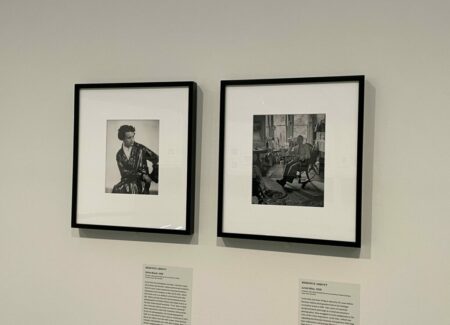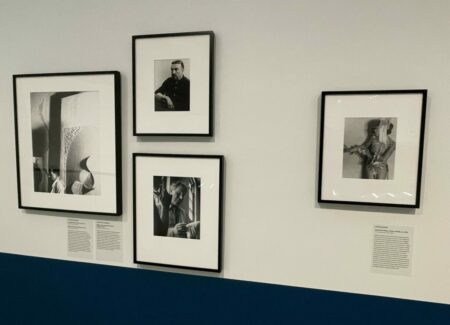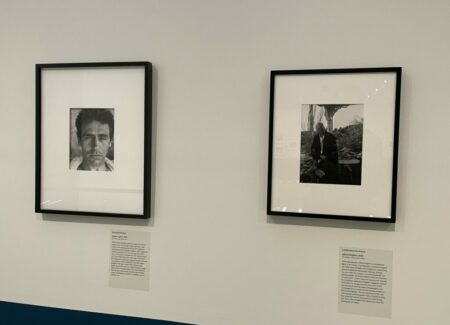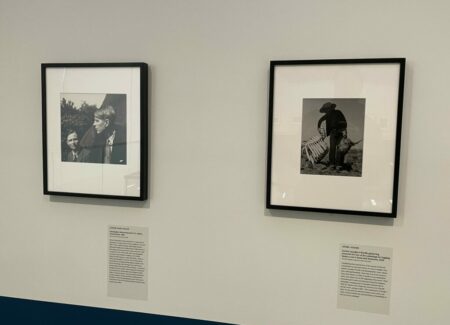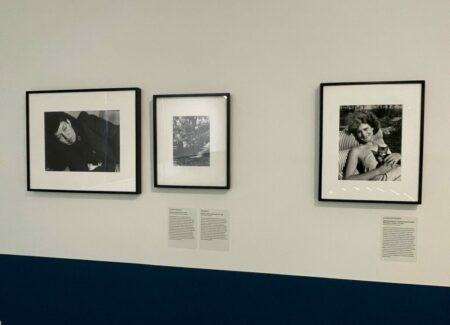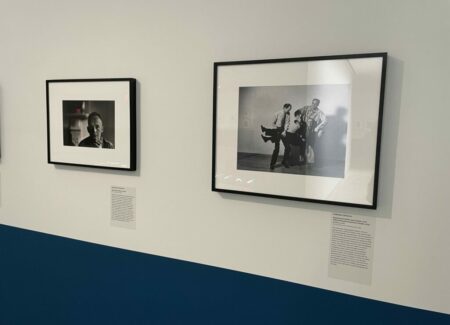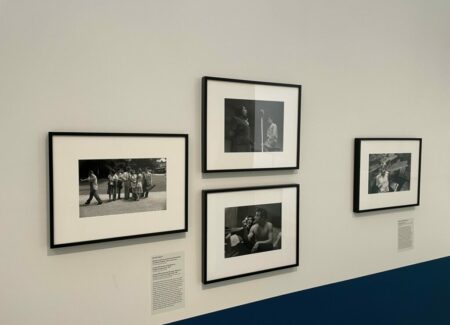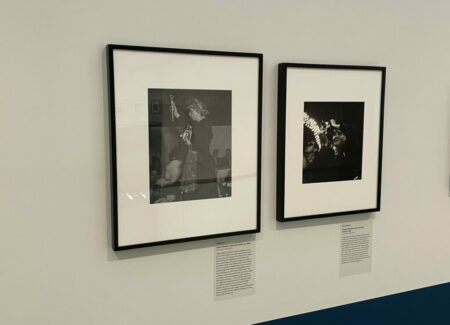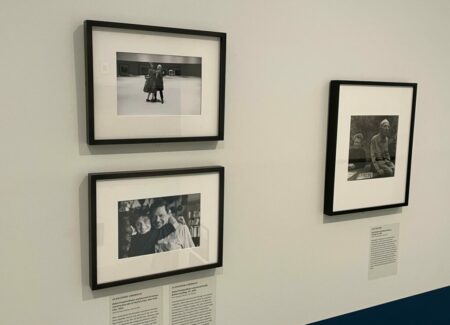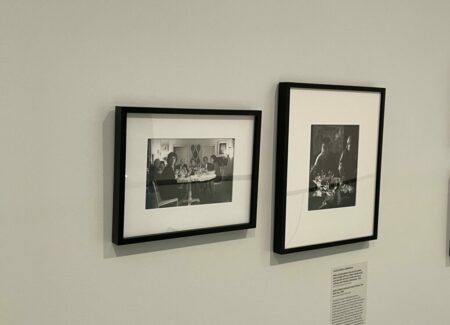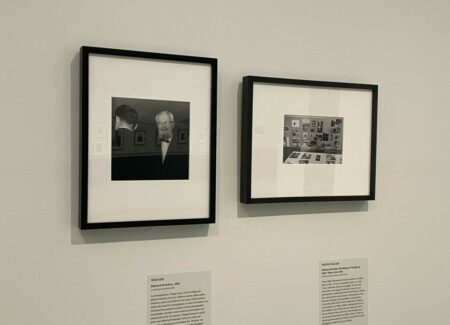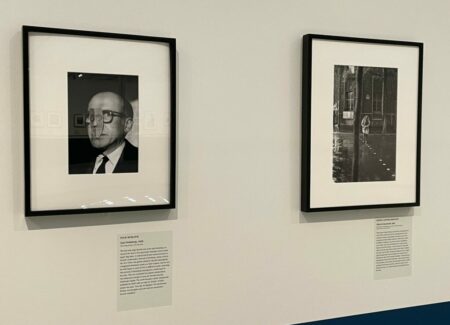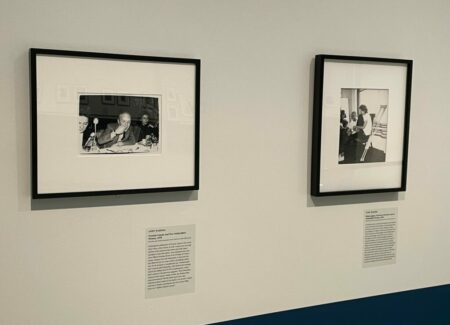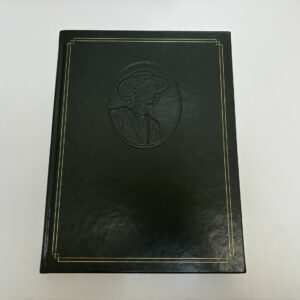JTF (just the facts): A group show consisting of a total of 36 black-and-white photographs made by 23 artists/photographers, the works framed in black and matted, and hung against white walls in the two catwalk galleries on the third floor of the museum. The exhibition was organized by Sara Ickow.
The following artists have been included in the exhibit, with the number of works on view and their dates as background:
- André Kertész: 1 gelatin silver print, 1925
- Nell Dorr: 1 gelatin silver print, c1915
- Edward Steichen: 2 gelatin silver prints, 1915/1982, 1927/1982
- Berenice Abbott: 2 gelatin silver prints, 1926, 1938
- Lotte Jacobi: 1 gelatin silver print, c1931
- Carlotta Corpon: 1 gelatin silver print, 1943
- Florence Henri: 2 gelatin silver prints, 1934/1976
- Consuelo Kanaga: 1 gelatin silver print, 1936
- Walker Evans: 1 gelatin silver print, 1937
- Ansel Adams: 1 gelatin silver print, 1938
- Louise Dahl-Wolfe: 1 gelatin silver print, 1938
- Alfred Eisenstaedt: 1 gelatin silver print, 1934
- Lee Sievan: 2 gelatin silver prints, 1946, 1951
- Barbara Morgan: 2 gelatin silver prints, 1941, 1942/1972
- Beaumont Newhall: 1 gelatin silver print, 1946
- Henri Cartier-Bresson: 2 gelatin silver prints, 1947, 1961
- Ruth Orkin: 3 gelatin silver prints, 1947, 1947/1985, 1951
- Weegee: 2 gelatin silver prints, c1946, 1961
- Lou Stoumen: 1 gelatin silver print, 1956
- Alexander Liberman: 4 gelatin silver prints, 1965
- Wayne Miller: 1 gelatin silver print, 1954
- Inge Morath: 1 gelatin silver print, 1966
- Andy Warhol: 2 gelatin silver prints, 1978, 1985
(Installation shots below.)
Comments/Context: In addition to the main Face to Face photographic portraiture exhibit now on view at the ICP (reviewed here), the museum has drawn a selection of photographs from its permanent collection, all made of by well known photographers of other artists and friends, and displayed them on the two catwalk galleries on the third floor, thereby providing some additional support and historical context for what’s on view below. Titled Between Friends, it’s an easygoing and eclectic gathering of pictures, and worth a quick detour.
The photographs on view (all in black-and-white and all from the 20th century) travel many of the same aesthetic pathways as the works in the main show, including images that get up close to faces, images that capture artists at work or in their studios, and images that document more casual moments among friends, and again, the central thesis considers the dynamic of artists making images of other artists (or photographers of other photographers) and the insights that come from that more balanced and engaged exchange.
While there are a couple of true studio portraits among these selections, including Berenice Abbott’s portrait of Sylvia Beach in a shiny jacket and Lotte Jacobi’s portrait of Anna May Wong in an exotic costume, many more of the images are less formal, often getting right up close to make a familiar face fill the frame. Walker Evans captures the weathered grace in the visage of his collaborator James Agee, Edward Steichen uses backlit silhouetting to give Alfred Stieglitz a sense of imposing inquisitive presence, and Beaumont Newhall finds a contemplative Henri Cartier-Bresson with his hands gently folded. And just when we might assume that all such interchanges were calm and serious, Inge Morath gives us Saul Steinberg with a playfully irreverent cardboard mask hanging off his nose.
When photographers make portraits of artists that work in other mediums, the connection is slightly different than when they point their cameras at other photographers. Edward Steichen’s portrait of Constantin Brancusi in his studio is relatively formal, with the bearded sculptor posed among his clustered sculptures like one of the artworks; an image of Robert Delaunay by Florence Henri has a similarly serious artfulness, with the artist seen in profile near one of his paintings with its own sinuous vertical curves. More casual are Ansel Adams’ image of Georgia O’Keeffe lugging a cow’s head and skeleton through the desert, and Henri Cartier-Bresson’s picture of Alberto Giacometti crossing the street in the Parisian rain, with his raincoat pulled over his head. The fun gets even more lively in Alexander Liberman’s images of the painter Helen Frankenthaler, one of her dancing with Barnett Newman and another of her comfortably hugging David Smith.
Several photographs in this show capture photographers at work, where no mannered posing or mugging for the camera is really possible. Weegee spies Lisette Model holding up her flash and watching her target with steely eyed precision, a net bag of used bulbs draped from her forearm. The tables are then turned on him by Lee Sievan, who catches Weegee working in a crowd with his camera pointed upward, its circular lens echoed by the expressive arc of lights behind him. And Wayne Miller finds Edward Steichen literally lying down on the job, outstretched on the floor arranging mock-up prints on a wall for his landmark “Family of Man” exhibit.
Other pictures feel more personal, like Berenice Abbott’s quiet image of Lewis Hine in his rocking chair in his cluttered living room or Lou Stoumen’s portrait of Edward and Brett Weston posed together sitting at a picnic table in Carmel. A lighter touch emerges in Barbara Morgan’s picture of Ansel Adams, Beaumont Newhall, and Willard Morgan goofing around, and in Alfred Eisenstaedt’s oddball portrait of Margaret Bourke-White in a lounge chair with a kitten on her lap, the closeness of the relationship between photographer and sitter encouraging moods that feel more comfortable and authentic.
This is a small exhibit that revels in the possibilities of eclectic connection, digging out rarities from the storage boxes that likely haven’t been shown in many a year. There’s something smartly endearing and relatable about such an effort, in that it takes the conceptual ideas of the main Face to Face exhibit and brings them back down to Earth a bit, rooting in them in the sprawling history of photography, as embodied by the museum’s permanent collection. As a bolt-on exhibit, Between Friends doesn’t really stand as well on its own without the proximity of the main show, but as a low key riff on the ideas at work, it successfully brings the focus back home to the ICP and its unique vantage point on the medium.
Collector’s POV: Since this is a museum exhibition, drawn from the permanent collection, there are of course no posted prices. And given the large number of photographers included in the show, we will forego our usual discussion of individual gallery representation relationships and secondary market histories.
